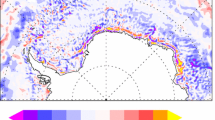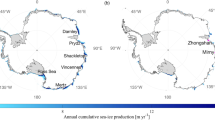Abstract
Although it is well known that sea-ice regions are important components of the Earth's climate system, the exchanges of energy between ocean, ice and atmosphere are not well understood. The majority of past observational and modelling studies of atmosphere-surface interactions over sea-ice regions were primarily concerned with airflow over a single, isolated area of open water. The more realistic situations of multiple polynyas within a sea-ice field and different areal concentrations of sea ice were studied here. Spatial structure of the atmospheric boundary layer in response to this surface was simulated using a high-resolution numerical model. A sea-ice concentration of 80%, typical of the Southern Ocean sea-ice zone, was maintained within a 100-km wide domain. The effects of three polynya characteristics were assessed: their horizontal extent; local concentration of sea ice (LCI); and their arrangement with ice floes. Over polynyas of all sizes distinct plumes of upward heat flux, their width and height closely linked to polynya width, resulted in mixed layers 600 to 1000 m deep over and downwind of the polynyas, their depth increasing with polynya width. Mean surface heat flux (MSHF) increased with size in polynyas less than 30 km wide. The air-to-ice MSHF over the first 10 km of sea-ice downwind of each polynya and the domain-average surface heat flux increased linearly with polynya width. Turbulent kinetic energy plumes occurred over all polynyas, their heights and widths increasing with polynya widths. Downward flux of high momentum air in the plumes caused increased wind speeds over polynyas in the layer from about 300–1000 m above the surface, the depth varying directly with polynya width. MSHFs decreased as LCIs increased. The arrangement of polynyas had relatively little effect on the overall depth of the modified layer but did influence the magnitude and spatial structure of vertical heat transfer. In the two-polynya case the MSHF over the polynyas was larger when they were closer together. Although the MSHF over the sea ice between the polynyas decreased in magnitude as their separation increased, the percentage of the polynya-to-air heat recaptured by this ice floe increased fivefold.
Similar content being viewed by others
References
Alam, A. and Curry, J.: 1995, ‘Lead-Induced Atmospheric Circulations’, J. Geophys. Res. 100, 4643–4651.
Alam, A. and Curry, J. A.: 1997, ‘Determination of Surface Turbulent Fluxes over Leads in Arctic Sea Ice’, J. Geophys. Res. 102, 3331–3343.
Allison, I. F.: 1973, ‘A Sample Study of the Energy Fluxes Preceding and Accompanying the Formation of Antarctic Sea Ice’, in S. Orvig (ed.), WMO Tech. Note 129, 115–132.
Allison, I.: 1989a, ‘Pack-Ice Drift off East Antarctica and Some Implications’, Ann. Glaciol. 12, 1–8.
Allison, I.: 1989b, ‘The East Antarctic Sea Ice Zone: Ice Characteristics and Drift’, GeoJournal 18.1, 103–115.
Allison, I., Tivendale, C.M., Akerman, G. J., Tann, J. M., and Wills, R. H.: 1982, ‘Seasonal Variations in the Surface Energy Exchanges over Antarctic Sea Ice and Coastal Waters’, Ann. Glaciol. 3, 12–16.
Allison, I., Brandt, R. E., and Warren, S. G.: 1993, ‘East Antarctic Sea Ice: Albedo, Thickness Distribution and Snow Cover’, J. Geophys. Res. 98, 12,417–12,429.
Andreas, E. L.: 1980, ‘Estimation of Heat and Mass Fluxes over Arctic Leads’, Mon. Wea. Rev. 108, 2057–2063.
Andreas, E. L. and Murphy, B.: 1986, ‘Bulk Transfer Coefficients for Heat and Momentum over Leads and Polynyas’, J. Phys. Oceanog. 16, 1875–1883.
Andreas, E. L., Paulson, C. A., Williams, R. M., Lindsay, R. W., and Businger, J. A.: 1979, ‘The Turbulent Heat Flux from Arctic Leads’, Boundary-Layer Meteorol. 17, 57–91.
Andreas, E. L., Tucker, W. B. III, and Ackley, S. F.: 1984, ‘Atmospheric Boundary Layer Modification, Drag Coefficient and Surface Heat Flux in the Antarctic Marginal Ice Zone’, J. Geophys. Res. 89, 649–661.
Atkinson, B.W.: 1995, ‘Orographic and Stability Effects on Valley-Side Drainage Flows’, Boundary-Layer Meteorol. 75, 403–428.
Atkinson, B. W. and Shahub, A. N.: 1994, ‘Orographic and Stability Effects on Day-Time, Valley-Side Slope Flows’, Boundary-Layer Meteorol. 68, 275–300.
Ballard, S. P. and Golding, B. W.: 1991, ‘Basic Model Formulation’, Mesoscale Documentation Paper, 4, Meteorological Office, Bracknell, U.K., 42 pp.
Barry, R. G., Serreze, M. C., Maslanik, J. A., and Preller, R. H.: 1993, ‘The Arctic Sea Ice – Climate System: Observations and Modelling’, Rev. Geophys. 31, 397–423.
Brummer, B.: 1996, ‘Boundary-Layer Modification in Wintertime Cold Air Outbreaks from the Arctic Sea Ice’, Boundary-Layer Meteorol. 80, 109–125.
Brummer, B.: 1997, ‘Boundary Layer Mass, Water and Heat Budgets in Wintertime Cold-Air Outbreaks from the Arctic Sea Ice’, Mon. Wea. Rev. 125, 1824–1837.
Brummer, B., Rump, B., and Kruspe, G.: 1992, ‘A Cold Air Outbreak near Spitsbergen in Springtime – Boundary-Layer Modification and Cloud Development’, Boundary-Layer Meteorol. 61, 13–46.
Burk, S. D., Fett, R. W., and Englebretson, R. E.: 1997, ‘Numerical Simulation of Cloud Plumes Emanating from Arctic Leads’, J. Geophys. Res. 102, 16,529–16,544.
Cavalieri, D. J. and Martin, S.: 1985, ‘A Passive Microwave Study of Polynyas along the Antarctic Wilkes Land Coast, Oceanology of the Antarctic Continental Shelf’, in S. S. Jacobs (ed.), Antarctic Res. Ser. 43, 227–252.
Comiso, J. C. and Gordon, A. L.: 1987, ‘Recurring Polynyas over the Cosmonaut Sea and the Maud Rise’, J. Geophys. Res. 92, 2819–2833.
Dare, R. A. and Atkinson, B.W.: 1999, ‘Numerical Modelling of Atmospheric Response to Polynyas in the Southern Ocean Sea Ice Zone’, J. Geophys. Res. 104(D1), 16,691–16,708.
den Hartog, G., Smith, S. D., Anderson, R. J., Topham, D. R., and Perkin, R. G.: 1983, ‘An Investigation of a Polynya in the Canadian Archipelago, 3. Surface Heat Flux’, J. Geophys. Res. 88, 2911–2916.
Drinkwater, M. R. and Lytle, V. I.: 1997, ‘ERS 1 Radar and Field-Observed Characteristics of Autumn Freeze-Up in the Weddell Sea’, J. Geophys. Res. 102, 12,593–12,608.
Fett, R. W., Burk, S. D., Thompson, W. T., and Kozo, T. L.: 1994, ‘Environmental Phenomena of the Beaufort Sea Observed during the Leads Experiment’, Bull. Amer.Meteorol. Soc. 75, 2131–2145.
Garratt, J. R.: 1992, The Atmospheric Boundary Layer, Cambridge University Press, Cambridge, U.K., 316 pp.
Glendening, J. W.: 1995, ‘Horizontally Integrated Atmospheric Heat Flux from an Arctic Lead’, J. Geophys. Res. 100, 4613–4620.
Glendening, J. W. and Burk, S. D.: 1992, ‘Turbulent Transport from an Arctic Lead: A Large-Eddy Simulation’, Boundary-Layer Meteorol. 59, 315–339.
Golding, B. W.: 1990, ‘The Meteorological Office Meso-Scale Model’, Meteorol. Mag. 119, 81–96.
Hartmann, J., Kottmeier, C., and Raasch, S.: 1997, ‘Roll Vortices and Boundary-Layer Development during a Cold Air Outbreak’, Boundary-Layer Meteorol. 84, 45–65.
Knapp, W. W.: 1967, ‘Formation, Persistence and Disappearance of Open Water Channels Related to the Meteorological Conditions along the Coast of the Antarctic Continent’, WMO Tech. Note 87, Polar Meteorology, 89–104.
Kondratyev, K. Y., Johannessen, O. M., and Melentyev, V. V.: 1996, High Latitude Climate and Remote Sensing, Wiley-Praxis, Chichester, U.K., 200 pp.
Kottmeier, C. and Engelbart, D.: 1992, ‘Generation and Atmospheric Heat Exchange of Coastal Polynyas in the Weddell Sea’, Boundary-Layer Meteorol. 60, 207–234.
Kottmeier, C. and Hartig, R.: 1990, ‘Winter Observations of the Atmosphere over Antarctic Sea Ice’, J. Geophys. Res. 95, 16,551–16,560.
Kurtz, D. D. and Bromwich, D. H.: 1985, ‘A Recurring, Atmospherically Forced Polynya in Terra Nova Bay, in Oceanology of the Antarctic Continental Shelf’, in S. S. Jacobs (ed.), Antarctic Res. Ser. 43, 177–201.
Lo, A. K.-F.: 1986, ‘On the Boundary Layer Flow over a Canadian Archipelago Polynya’, Boundary-Layer Meteorol. 35, 53–71.
Lytle, V. I. and Ackley, S. F.: 1996, ‘Heat Flux through Sea Ice in the Western Weddell Sea: Convective and Conductive Transfer Processes’, J. Geophys. Res. 101, 8853–8868.
Martinson, D. G.: 1993, ‘Ocean Heat and Seasonal Sea Ice Thickness in the Southern Ocean’, in W. R. Peltier (ed.), Ice in the Climate System, NATO ASI Series I 12, 597–609.
Martinson, D. and Wamser, C.: 1990, ‘Ice Drift and Momentum Exchange in Winter Antarctic Pack Ice’, J. Geophys. Res. 95, 1741–1755.
Massom, R. A., Drinkwater, M. R., and Haas, C.: 1997, ‘Winter Snow Cover on Sea Ice in the Weddell Sea’, J. Geophys. Res. 102, 1101–1117.
Mellor, M.: 1960, ‘Sea Ice Measurements at Mawson and Davis, 1954–58’, Aust. Nat. Antarctic Res. Exped. Interim Rep. 19.
Overland, J. E., Reynolds, R. M., and Pease, C. H.: 1983, ‘A Model of the Atmospheric Boundary Layer over the Marginal Ice Zone’, J. Geophys. Res. 88, 2836–2840.
Parkinson, C. L. and Cavalieri, D. J.: 1982, ‘Interrannual Sea-Ice Variations and Sea-Ice/Atmospheric Interactions in the Southern Ocean, 1973–1975’, Ann. Glaciol. 3, 249–254.
Parkinson, C. L. and Washington, W. M.: 1979, ‘A Large-Scale Numerical Model of Sea Ice’, J. Geophys. Res. 84, 311–337.
Russell-Head, D. and Simmonds, I.: 1993, Temporal Structure of Surface Weather Parameters at Casey, Davis, Mawson and Macquarie Island, Rep. 35 Meteorol. Sect., Sch. of Earth Sci., Univ. of Melbourne, 181 pp.
Schnell, R. C, Barry, R. G., Miles, M.W., Andreas, E. L., Radke, L. F., Brock, C. A., McCormick, M. P., and Moore, J. L.: 1989, ‘Lidar Detection of Leads in Arctic Sea Ice’, Nature 339, 530–532.
Smith, S. D., Anderson, R. J., den Hartog, G., Topham, D. R., and Perkin, R. G.: 1983, ‘An Investigation of a Polynya in the Canadian Archipelago, 2. Structure of Turbulence and Sensible Heat Flux’, J. Geophys. Res. 88, 2900–2910.
Streten, N. A.: 1973, ‘Satellite Observations of the Summer Decay of the Antarctic Sea-Ice’, Archiv Meteorol. Geophys. Bioklimatol. Ser. A 22, 119–134.
Streten, N. A. and Pike, D.: 1984, ‘Some Observations of the Sea-Ice in the Southwest Indian Ocean’, Aust. Meteorol. Mag. 32, 195–206.
Tapp, M. C. and White, P.W.: 1976, ‘A Non-Hydrostatic Mesoscale Model’, Quart. J. Roy. Meteorol. Soc. 102, 277–296.
Wamser, C. and Martinson, D. G.: 1993, ‘Drag Coefficients for Winter Antarctic Pack Ice’, J. Geophys. Res. 98, 12,431–12,437.
Worby, A. P. and Allison, I.: 1991, ‘Ocean-Atmosphere Energy Exchange over Thin, Variable Concentration Antarctic Pack Ice’, Ann. Glaciol. 15, 184–190.
Author information
Authors and Affiliations
Rights and permissions
About this article
Cite this article
Dare, R.A., Atkinson, B.W. Atmospheric Response To Spatial Variations In Concentration And Size Of Polynyas In The Southern Ocean Sea-Ice Zone. Boundary-Layer Meteorology 94, 65–88 (2000). https://doi.org/10.1023/A:1002442212593
Issue Date:
DOI: https://doi.org/10.1023/A:1002442212593




